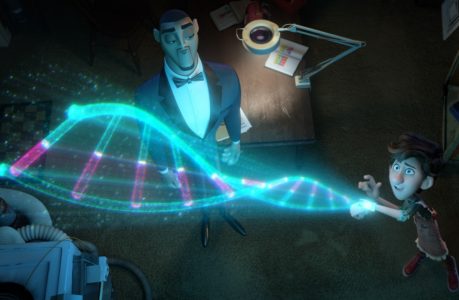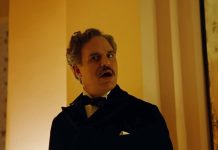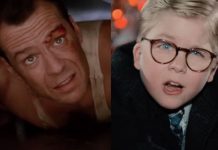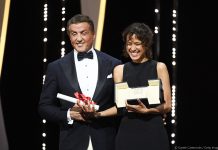SALOUMEH FARHADIAN ARTNEWSPRESS: In the animated spy comedy adventure Spies in Disguise, super spy Lance Sterling (voiced by Will Smith) finds his life taking an unexpected turn that forces him to team up with scientist Walter Beckett (voiced by Tom Holland) for the ultimate mission. In order to succeed, the otherwise suave and debonair spy must allow himself to be transformed into a pigeon, so that the duo can save the world. The film also stars the voices talents of Karen Gillan, Rashida Jones, DJ Khaled, Rachel Brosnahan, Reba McEntire, Ben Mendelsohn, and Masi Oka.
At a roundtable interview during the film’s Los Angeles press day, co-directors Nick Bruno and Troy Quane talked about how they came to direct this project, pigeon physical comedy, finding the right level of action violence in a kids’ film, favorite gags, Disney’s influence on the final product, and more.
COLLIDER: How did this movie begin, and what made you guys want to take this on?

NICK BRUNO: I was working as Head of Animation on The Peanuts Movie, which was awhile ago, and I read the first draft of this script. What I fell in love with was that it had the promise of all of the big action spy movies and it had all of the fun tropes, but at its core, it’s really about working together. I loved having a story that tells that in a spy world, where nobody trusts each other and nobody works together. I really fell in love with the project and thought it could be a lot of fun and have a really good message, and had to work on it.
TROY QUANE: Same thing, I read the script in October of 2013, when I was still living out here in L.A. It was about a spy turning into a pigeon, which was crazy, but it was a spy movie, which is my favorite genre. It was this opportunity to make a really big, bold comedy, travel the world, and have action set pieces, but it had really great characters at its heart. The characters of Lance and Walter were really defined and felt like there was something really interesting to explore there, in this relationship. So, we packed up the carriages and rolled east, out to Connecticut, and moved to Blue Sky. That’s actually where I met Nick, when we came together on this film. Like Lance and Walter, we were a match made in heaven.
Was there ever any conversation about letting Tom Holland use his own British accent?
BRUNO: Yes, there was. But ultimately, for the character of Walter, Walter is somebody who hasn’t really gone out and seen the world, so in our conversations with Tom, we all felt, as a group, that it was better to keep him just as a kid who grew up in D.C. and experienced a tragic past. He’s still worldly in that experience, but you really want to feel like, when he’s out in the world, this is the first time that he’s experiencing this new adventure, unlike Lance Sterling.
QUANE: To the question of accents, the fun of these spy movies is that they’re global, and we really wanted to make sure that there was a texture for that pallet of sounds. So, while Tom uses an American accent, we’ve got Karen Gillan who’s using her Scottish accent, Ben Mendelsohn uses his Australian accent, and we made sure to cast Masi [Oka] and have the Japanese characters peaking true to their dialect. We didn’t want it to be someone just doing a funny accent. We really wanted it to be authentic. That was really important. And then, even within the American dialect, we have Reba McEntire, who comes in with this wonderful Southern twang. It was about texture, and making it feel big and broad in its scope.
BRUNO: It represents the world that we see.
You guys have a lot of pigeon physical comedy in this. How does one approach that?

QUANE: Carefully. No. That was one of the really fun aspects. We were able to get into the movie from a completely different point of view, with the pigeon antics. Pigeons are those things that most people ignore, or think are gross, but they’re really phenomenal. That’s where Walter’s genius comes into play. As a spy, there’s no better thing to be than a pigeon. They’re in every major city, around the world, and people ignore them, for the most part, but they’ve got all kinds of really cool special abilities. Pigeons can fly really fast, up to 92.7 miles an hour. The only natural predator they have is the Peregrine falcon. Pigeons can bank it, almost 90 degrees, which is unbelievable. We’ve watched YouTube videos of them drafting behind cars in traffic. It’s unbelievable. They’ve got eyes on the side of their head, so they can see in almost 360 degrees. Nobody can sneak up behind them, which is a pretty cool thing, if you’re a spy. They can see UV light, so they can see infrared sensors and lasers. We just had a lot of fun with that. The idea of being able to see someone’s face and your butt, at the same time, became a really big joke in the movie. It was really important that we took Lance Sterling, who is this amazing human physical specimen, with broad shoulders, and who’s strong and sexy, and turned him into this really funny little dumpy bird shape was really important. Part of the fun of the pigeons was that all of the other animals in this world are just that. They’re animals. We really needed that grounding reality, so that you felt the difference of this human trapped in a pigeon body versus other real world pigeons. Lance is the only one who can talk. He’s got little eyebrows and you can read his expressions. It’s this idea of this agent that flies solo becoming a flock animal, and having to learn to deal with all these other quirky, crazy birds.
Can you talk about the aesthetic of the film, and finding the look and vibe that you wanted?
BRUNO: When we first started, we did our research, and really enjoyed going back and watching all of the spy films. One of the things that we really loved was all of those title sequences, but because this movie is fully animated, we could do more of that. We looked at some of the Saul Bass stuff and some of their angularity, shape and color language, and we just tried to find ways to get that DNA into every frame of the film.
QUANE: But not necessarily make it feel like a vintage throwback. We really wanted it to feel contemporary and current, so it was finding the aesthetic design principles that we appreciated there, but making it feel very current, so it didn’t feel like it was a throwback.
BRUNO: We did this same thing with the music, and that’s why we chose Mark Ronson. Mark does a great job of taking some throwback vibes, but giving it a contemporary spin, so that it really sounds full and contemporary.
QUANE: That big brass sound is so cool.
Toxic masculinity can be inherent in the spy genre, and you have a message of gender equality in this. Was that something that was particularly important to you?
QUANE: Yeah, absolutely! And that came down to some tricky casting. That’s how we ended up with Will Smith. With Lance Sterling, we wanted to create a spy that stood alongside all of those other great movie spies. But to that point, he’s a character who doesn’t work well with others and who’s very confident, but is still very charismatic. And then, there’s a lot of balancing to having that happen, and we needed someone like Will, who could come in and really walk that line delicately. We love to cheer for those characters, but at the same time, we have to acknowledge that sometimes they have the wrong end of the stick, in how they see the world. That’s where bringing in someone like Walter, and having some like Tom Holland, who played it with such sincerity, to not show Lance that he’s wrong, but to show him that there’s another way. There’s maybe a broader way of looking at the world, and a broader way of interacting with the world. It felt like it was a very poignant part of the message, especially in today’s day and age, to be honest about.
Did you watch any spy movies for inspiration on [Spies in Disguise]?
BRUNO: Yeah. We like to think of this movie as a love letter to all spy movies. We know that for kids, this might be their first real spy movie, so we wanted to do it justice. We did our research. We went back and watched all of the Bonds, the Bournes and the Hunts. There’s definitely some homages in there to some of the other movies, but at the same time, we wanted to do something different. Because it’s a movie for kids, we felt there was a responsibility to say something about teamwork. It’s not just about violence and an explosions. It’s really about how coming together can save the world.
Were there ever any conversations with the ratings board about how much action violence there could be, in a kids’ movie?

QUANE: No. Actually, not at all. But we were very specific with how we approached violence in the movie. It felt false to pretend that there wasn’t violence in the world. If you turn on the news, you know that’s not the case, but we were really specific in how we were using it. We weren’t glorifying it. It was mainly at the hands of the bad guys. You needed that to counterpoint Walter’s message of saying, “There’s a better way.” When we use violence to solve our issues, all we do is create more enemies. We draw a line that puts people on the other side of that. We have to reach across that line and bring people together. So, because the messaging was on point like that, and we really trying to say something with the movie, the action sits into that. It doesn’t feel arbitrary or gratuitous. It’s comedic, and it’s a lot of fun. It’s a bunch of pigeons and a clumsy kid, and goofy stuff happening. We wanted to make it fun, and not too intense.
BRUNO: In no way did we want to glorify violence ‘cause our message is against violence.
Did you have any favorite gags in this, and did you have any that you had to cut out?
BRUNO: There’s always a bunch, and we’ll save those for the further adventures. One of my favorite moments is with Masi Oka’s character, Kimura. Our heroes are stuck in a position where they have to find a way to block a door, and using one of Walter’s non-lethal gadgets of goo-ifying bones, we turn Kimura into this giant lump of clay that we end up rolling to the door, and it’s just a lot of fun.
In the end credits, you thank some of the Disney animators. What was their influence on this?
QUANE: With any movie you see, it takes a village. We’ve been on this movie for four and a half years, so it’s nice to sometimes get a bit of perspective. You think you’ve got it and that it’s working right, but it’s nice to get the opinions of people that you respect and appreciate to tell you how they feel about it and whether we’re on the right track. It was great. They were very positive.
BRUNO: We’re part of the Disney family now, and it’s great that they’ve opened their arms and embraced us. We’ve all been working together, which is awesome.
When did you start working with Disney?
QUANE: In March of this year.
BRUNO: We started off at Fox, but one of the world’s largest entertainment mergers happened in the middle of that. But we’re all happy about it, on this end.
QUANE: And they’ve been awesome. They loved the movie. They gave us a Christmas day release, which is huge. That shows a lot of confidence. It’s been fantastic.
Spies in Disguise is now playing in theaters. For more on this fun, new animated flick, be sure to check out our interview with supporting cast member Masi Oka.
https://collider.com
Christina Radish
























